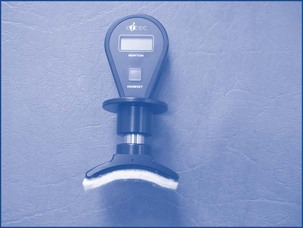Chapter 1 Acute Paediatrics
Neuromuscular disorders
Assessment
Subjective assessment
• During the initial assessment, an overview of the onset, progression and major functional difficulties needs to be established.
• Is there any family history of muscle disorders or developmental delay?
• Are the problems getting worse, improving or staying the same?
• If function or power has deteriorated, has this happened gradually or rapidly?
• Is the child experiencing symptoms of nocturnal hypoventilation?
• Weaker children with neuromuscular conditions often suffer from nocturnal hypoventilation, i.e. they under-breathe when asleep.
• To ascertain whether a child may be developing this problem, the following questions should be asked:
Ambulant children
• When assessing an ambulant child the following need to be considered:
Objective assessment
In some centres, respiratory function is tested by physiotherapists.
For babies and infants, an assessment of developmental milestones is needed.
Muscle power:
• Assessment of muscle power in clinical practice on the whole follows the MRC grading/Oxford scale of 0–5 (MRC 1976).
• Standardised starting positions must be used to ensure reproducibility.
• Pure movements are tested at the neck, trunk, hips, knees and ankles, shoulders, elbows forearms and wrists.
• Rotation movements are not tested, as they are not pure movements. Although strong and often used to compensate for weakness, it is difficult to separate the components of the movement.
• Objective measurement of force using a hand-held dynamometer, also known as myometry, has been shown to be more reliable as a means of measuring muscle power in children (Wadsworth et al 1987) (Figure 1.1).
Joint contractures
• Contractures may be present which can influence joint range of motion.
• Caused by shortening of the muscle and other structures around the joint.
• There are children who have joint hypermobility or a combination of hypermobility and contractures.
• Marked hypermobility can be as debilitating as contractures and should be recorded.
• Contractures are more severe and widespread in non-ambulant children.
• They are apparent at birth in many of the congenital muscular dystrophies, but can occur in all of the neuromuscular disorders over time.
• The site of contractures can be related to the underlying pattern of muscle weakness and to the functional level of the child (ambulant or non-ambulant).
• Contractures are important where they interfere with function.
• The most frequently encountered contractures are:
Measurement of joint range
• Commonly joint range is measured using goniometry.
• Standardised starting positions and measuring methods need to be defined to ensure repeatability.
• It is also very important to know what constitutes ‘normal’ range when considering the presence of reduced joint range.
• Neck range of movement and spinal mobility are routinely assessed.
• Hamstring range is measured routinely recording the popliteal angle. However tighter hamstrings are a prerequisite for children with pelvic weakness, to ensure the highest level of function.
• Hamstring tightness is not considered to be a problem unless it is associated with collagen disorders, e.g. Ullrich congenital muscular dystrophy (CMD) or Bethlem CMD.
Mobility
• When a child is ambulant, timed tests are used to provide quantitative measures of mobility.
• With the timed 10 metres, the child is instructed to ‘go’ as fast as they can.
• More recently, the 6 minute walk test (6MWT) has been introduced (Li et al 2005). Distance is measured over a course, recommended to be 25 metres long, and continued for 6 minutes with the distance walked being recorded.
Posture
Function
Summary
• Weakness and contractures are the major barriers to function.
• Many children will have or develop respiratory compromise.
• Many children will have spinal asymmetry that may require corrective surgery.
• It is not appropriate to keep assessing power and contractures in the older, weakest non-ambulant teenagers.
• Progressive disorders are frightening and the fears and anxieties of the parents and children will need to be managed in a sympathetic manner.
Musculoskeletal
• Assessment of a child requires an understanding of normal growth and development of the musculoskeletal system as well as an awareness of potential red flags.
• It is important to involve the whole team, family/carers and the child in all discussions from the outset, so that consequent management aims are realistic, relevant and achievable.
• Whilst both adults and children will attend the initial assessment with an element of anxiety, this tends to predominate in children and it can be harder to reason with them.
Subjective assessment
Pain
• The manner in which a child expresses pain will depend on their age and may manifest in the following ways:
• A child may only be able to give a vague description and localisation of pain
• Be aware of underplaying or exaggeration of symptoms in adolescents wanting to either participate in or avoid sports or other activities.
• Various pain assessment tools are available depending on the age and cognitive ability of the child, e.g. pain faces scale (Hicks et al 2001), paediatric pain profile (UCL, ICH, RCNI 2003).
Objective assessment
Baby
• The most rapid period of growth and development occurs in the first 18 months of life.
• A fastidious approach is vital as infants tend to be unable to indicate where problems are or to comply with assessment.
• Undress the whole child, irrespective of the referral, to avoid missing any orthopaedic problems or diagnostic clues.
Observation
• Overall size and proportion of child
• Count number, and check separation, of toes (indications of congenital abnormalities)
• Asymmetries (postural deformities are frequent in neonates and may occur as a result of intrauterine pressure or positioning)
• Any baby with asymmetries may have an increased risk of hip dysplasia
Stay updated, free articles. Join our Telegram channel

Full access? Get Clinical Tree









